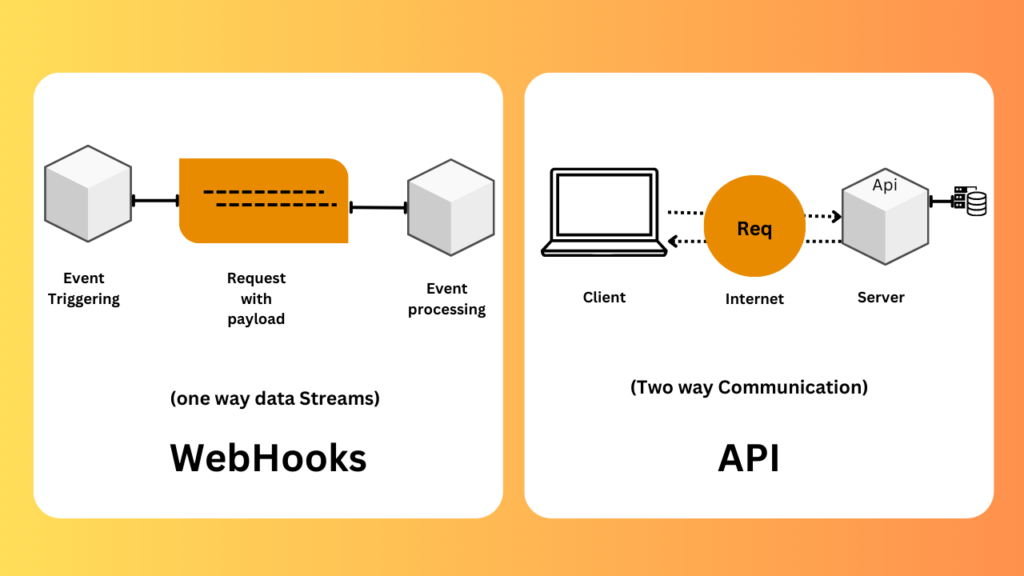In the realm of web development, understanding the Webhooks vs APIs is essential for optimizing communication between different systems and applications. Let’s delve deeper into these concepts and explore their real-world applications.
Webhooks: Automating Real-Time Updates
How Webhooks Work
Webhooks function as automated callbacks initiated by external events. Unlike APIs where requests are made to retrieve data, webhooks enable systems to automatically send data to predefined endpoints whenever a specific event occurs. This real-time push mechanism eliminates the need for continuous polling, enhancing efficiency and responsiveness.
Real-World Usage of Webhooks
1. Notifications in Chat Apps
Chat applications like Slack and Microsoft Teams leverage webhooks to deliver real-time notifications to users. Whether it’s new messages, mentions, or updates, webhooks facilitate instant communication, keeping users informed and engaged.
2. E-commerce Updates
In the realm of e-commerce, webhooks play a pivotal role in facilitating seamless transactions and order management. From order confirmations to shipping notifications, webhooks ensure timely updates for both merchants and customers, enhancing the overall shopping experience.
3. Monitoring and Alerts
Webhooks serve as indispensable tools in system monitoring and alerting. Monitoring platforms utilize webhooks to promptly notify administrators or relevant teams about critical events or anomalies, enabling swift action and issue resolution.
4. Marketing Automation
Marketing automation platforms leverage webhooks to streamline processes and enhance campaign effectiveness. By triggering actions such as sending confirmation emails or updating customer relationship management (CRM) systems in response to user interactions, webhooks enable personalized and targeted marketing efforts.
APIs: Facilitating Data Retrieval and Integration
Understanding APIs
APIs, or Application Programming Interfaces, provide a structured means of interacting with software applications. Acting as intermediaries between different systems, APIs enable seamless data retrieval and integration by defining the methods and protocols for communication.
Real-World Applications of APIs
1. Social Media Integration
APIs play a pivotal role in enabling social media integration across various platforms. By providing access to user data and authentication mechanisms, social media APIs facilitate seamless login and data sharing functionalities, enhancing user experiences.
2. Payment Gateways
Online payment services like PayPal and Stripe rely on APIs to enable secure and efficient transaction processing. By integrating payment APIs into websites and applications, businesses can offer diverse payment options and streamline checkout processes for customers.
3. Weather Apps
Weather applications utilize APIs from meteorological services to fetch real-time weather data and provide accurate forecasts to users. By integrating weather APIs, developers can deliver personalized and location-based weather updates, enhancing user engagement and satisfaction.
4. Maps and Location Services
Mapping and location-based services like Google Maps leverage APIs to provide users with comprehensive mapping functionalities. By integrating mapping APIs into applications, developers can offer features such as geocoding, route planning, and location-based search, enhancing navigation experiences.

Read About: What is CAPTCHA? How It Safeguards Websites Against Automated Attacks.
Conclusion
In conclusion, Webhooks and APIs serve distinct yet complementary roles in web development, facilitating seamless communication and data exchange between different systems and applications. While APIs enable structured data retrieval and integration, Webhooks automate real-time updates and event-driven workflows, enhancing system efficiency and responsiveness.
Frequently Asked Questions
- What is the difference between Webhooks and APIs? Webhooks are automated callbacks initiated by external events to send data to predefined endpoints, while APIs provide a structured means of interacting with software applications, facilitating data retrieval and integration.
- How do Webhooks function in web development? Webhooks automate real-time updates by triggering callbacks when specific events occur, eliminating the need for continuous polling and enhancing system efficiency and responsiveness.
- What are some real-world applications of Webhooks? Webhooks are commonly used in chat apps for notifications, e-commerce platforms for order updates, monitoring tools for alerts, and marketing automation systems for personalized actions based on user interactions.
- What role do APIs play in data retrieval and integration? APIs act as intermediaries between different systems, enabling seamless data retrieval and integration by defining methods and protocols for communication, facilitating tasks such as social media integration, payment processing, weather data retrieval, and mapping functionalities.
- How do Webhooks and APIs complement each other in web development? While APIs facilitate structured data retrieval and integration, Webhooks automate real-time updates and event-driven workflows, collectively enhancing system efficiency and responsiveness in web development projects.